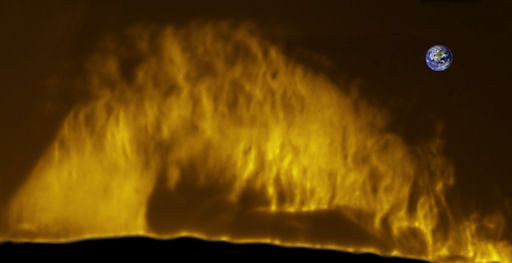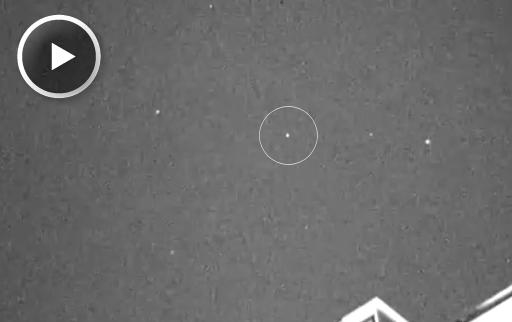MERCURY-DIRECTED CME: A significant coronal mass ejection (CME) blasted away from the sun's eastern hemisphere on Nov. 12th. Analysts at the Goddard Space Weather Lab say the cloud will hit Mercury on Nov. 13th at 1800 UT (+/- 7 hr) followed by Venus about one day later. The innermost planets are about to experience space weather. [CME: movie, forecast track]
REMARKABLE SOLAR ACTIVITY: There haven't been any strong solar flares in days. Nevertheless, some impressive activity is underway on the sun. For one thing, an enormous wall of plasma is towering over the sun's southeastern horizon. Stephen Ramsden of Atlanta, Georgia, took this picture on Nov. 11th:
"Solar forums all over the world are buzzing with Sun-stronomers proclaiming this to be the biggest prominence that many of them had ever witnessed," he says.
Remarkably, though, this is not the biggest thing. A dark filament of magnetism is snaking more than halfway around the entire sun: SDO image. From end to end, it stretches more than a million km or about three times the distance between Earth and the Moon. If the filament becomes unstable, as solar filaments are prone to do, it could collapse and hit the stellar surface below, triggering a Hyder flare. No one can say if the eruption of such a sprawling structure would be Earth directed.
"I cant help but wonder what could possibly come next since we are still over a year away from the forecasted Solar Maximum," adds Ramsden. "There's never been a better time to own a solar telescope than now!"
More Images: from Alan Friedman of Buffalo, NY; from Theo Ramakers of Social Circle, GA; from John Stetson of Falmouth, Maine; from Randy Shivak of Elyria, OH;from Steve Riegel of Albuquerque, NM; from Robert Arnold of Ilse of Skye, Scotland
DISAPPEARING TRICK: If you're a spy satellite, the ability to disappear could come in handy. US spysat Lacrosse 5 occasionally performs just such a trick. On Nov. 11th, satellite watcher Dr. Marco Langbroek of Leiden, the Netherlands, caught the orbiting radar suddenly fading to near invisibility:
"Lacrosse 5 is typically bright but occasionally performs what is known among observers as the 'disappearance trick,'" says Langbroek. "Its brightness suddenly drops 3 astronomonical magnitudes or more."
No one knows whether or not this is a deliberate form of stealth, but Langbroek doesn't think so:
"Maybe some part of the spacecraft such as its solar panels casts a shadow over the main body," he speculates. "Or perhaps the surface of Lacrosse 5 becomes less reflective at certain viewing angles. This could happen as the craft suddenly changes attitude for some reason." Other Lacrosse satellites do not perform the trick, at least not to this extent, suggesting that the design of Lacrosse 5 differs from its predecessors.
"Later in the movie a bright Soyuz rocket booster (81-008B) passes by as well," he adds. "This is a piece of space debris connected to the 1981 launch of a Russian military satellite."
Readers, would you like to try catching the tricks of Lacrosse 5? Local flyby times may be found on the web or on your smartphone.
Source: Space Weather News


No hay comentarios:
Publicar un comentario